Acer 1640, 1640Z User Manual
Aspire 1640 Series
User's Guide
Copyright © 2005. Acer Incorporated.
All Rights Reserved.
Aspire 1640 Series User's Guide
Original Issue: August 2005
Changes may be made periodically to the information in this publication without obligation to notify any person of such revisions or changes. Such changes will be incorporated in new editions of this manual or supplementary documents and publications. This company makes no representations or warranties, either expressed or implied, with respect to the contents hereof and specifically disclaims the implied warranties of merchantability or fitness for a particular purpose.
Record the model number, serial number, purchase date and place of purchase information in the space provided below. The serial number and model number are recorded on the label affixed to your computer. All correspondence concerning your unit should include the serial number, model number and purchase information.
No part of this publication may be reproduced, stored in a retrieval system, or transmitted, in any form or by any means, electronically, mechanically, by photocopy, recording or otherwise, without the prior written permission of Acer Incorporated.
Aspire 1640 Series Notebook PC
Model number: __________________________________
Serial number: ___________________________________
Date of purchase: ________________________________
Place of purchase: ________________________________
Acer and the Acer logo are registered trademarks of Acer Incorporated. Other companies' product names or trademarks are used herein for identification purposes only and belong to their respective companies.

iii
Disposal instructions
Do not throw this electronic device into the trash when discarding. To minimize pollution and ensure utmost protection of the global environment, please recycle.
USA
For electronic products containing an LCD/CRT monitor or display:
Lamp(s) inside this product contain mercury and must be recycled or disposed of according to local, state or federal laws. For more information, contact the Electronic Industries Alliance at www.eiae.org. For lamp-specific disposal information, check www.lamprecycle.org.
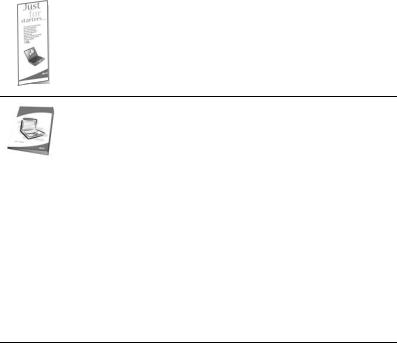
iv
First things first
We would like to thank you for making the Aspire series of notebook PC your choice for meeting your mobile computing needs.
Your guides
To help you use your Aspire, we have designed a set of guides:
First off, the Just for Starters... poster helps you get started with setting up your computer.
The printed User's Guide introduces you to the basic features and functions of your new computer. For more on how your computer can help you to be more productive, please refer to the AcerSystem User's Guide. This guide contains detailed information on such subjects as system utilities, data recovery, expansion options and troubleshooting. In addition it contains warranty information and the general regulations and safety notices for your notebook. It is available in Portable Document Format (PDF) and comes preloaded on your notebook. Follow these steps to access it:
1Click on Start, All Programs, AcerSystem.
2Click on AcerSystem User's Guide.
Note: Viewing the file requires Adobe Reader. If Adobe Reader is not installed on your computer, clicking on AcerSystem User's Guide will run the Adobe Reader setup program first. Follow the instructions on the screen to complete the installation. For instructions on how to use Adobe Reader, access the Help and Support menu.
Basic care and tips for using your computer
Turning your computer on and off
To turn on the computer, simply press and release the power button below the LCD screen beside the easy-launch buttons. See "Front view" on page 1 for the location of the power button.

v
To turn the power off, do any of the following:
•Use the Windows shutdown command
Click on Start, Turn Off Computer, then click on Turn Off.
•Use the power button
You can also shut down the computer by closing the display cover, or by pressing the sleep hotkey <Fn> + <F4>.
Note: If you cannot power off the computer normally, press and hold the power button for more than four seconds to shut down the computer. If you turn off the computer and want to turn it on again, wait at least two seconds before powering up.
Taking care of your computer
Your computer will serve you well if you take care of it.
•Do not expose the computer to direct sunlight. Do not place it near sources of heat, such as a radiator.
•Do not expose the computer to temperatures below 0 ºC (32 ºF) or above 50 ºC (122 ºF).
•Do not subject the computer to magnetic fields.
•Do not expose the computer to rain or moisture.
•Do not spill water or any liquid on the computer.
•Do not subject the computer to heavy shock or vibration.
•Do not expose the computer to dust or dirt.
•Never place objects on top of the computer.
•Do not slam the computer display when you close it.
•Never place the computer on uneven surfaces.
Taking care of your AC adapter
Here are some ways to take care of your AC adapter:
•Do not connect the adapter to any other device.
•Do not step on the power cord or place heavy objects on top of it. Carefully route the power cord and any cables away from foot traffic.
•When unplugging the power cord, do not pull on the cord itself but pull on the plug.
•The total ampere ratings of the equipment plugged in should not exceed the ampere rating of the cord if you are using an extension cord. Also, the total current rating of all equipment plugged into a single wall outlet should not exceed the fuse rating.
vi
Taking care of your battery pack
Here are some ways to take care of your battery pack:
•Use only batteries of the same kind as replacements. Turn the power off before removing or replacing batteries.
•Do not tamper with batteries. Keep them away from children.
•Dispose of used batteries according to local regulations. Recycle if possible.
Cleaning and servicing
When cleaning the computer, follow these steps:
1Turn off the computer and remove the battery pack.
2Disconnect the AC adapter.
3Use a soft, moist cloth. Do not use liquid or aerosol cleaners.
If either of the following occurs:
•the computer has been dropped or the body has been damaged;
•the computer does not operate normally
please refer to "Frequently asked questions" on page 23.
Caution
Changes or modifications not expressly approved by the manufacturer could void the user's authority, which is granted by the Federal Communications Commission, to operate this computer.
Operation conditions
This device complies with Part 15 of the FCC Rules. Operation is subject to the following two conditions: (1) This device may not cause harmful interference, and (2) This device must accept any interference received, including interference that may cause undesired operation.
Users are requested to follow the RF safety instructions for wireless option devices that are included in the user's manual of each RF option device.
An improper installation or unauthorized use may cause harmful interference to radio communications. Also, any tampering of the internal antenna will void the FCC certification and your warranty.
To prevent radio interference to the licensed service, this device is intended to be operated indoors, and installation outdoors is subject to licensing.
For more information about our products, services, and support information, please visit our website: http://global.acer.com.
Disposal instructions First things first
Your guides
Basic care and tips for using your computer Turning your computer on and off Taking care of your computer Taking care of your AC adapter Taking care of your battery pack Cleaning and servicing
An Aspire tour Front view
Closed front view Left view
Right view Rear view Base view
Specifications Indicators Easy-launch buttons Touchpad
Touchpad basics Using the keyboard
Lock keys and embedded numeric keypad Windows keys
Hotkeys Special keys
Ejecting the optical (CD or DVD) drive tray Using a computer security lock
Audio
Adjusting the volume Using the system utilities
Acer eManager
Acer GridVista (dual-display compatible) Launch Manager
Norton AntiVirus Frequently asked questions
Requesting service
International Travelers Warranty (ITW) Before you call
Acer Arcade (for selected models) Arcade hotkeys
InstantOn Arcade mode Finding and playing content
Settings Arcade controls
Navigation controls Player controls
iii iv iv iv iv v v vi vi 1 1 2 3 4 4 5 6 9 10 11 11 13 13 14 14 16 17 17 18 18 19 19 20 21 22 23 26 26 26 27 28 28 29 29 30 30 30
Contents
Virtual keyboard |
31 |
Background mode |
31 |
Cinema |
32 |
Settings |
32 |
Album |
33 |
Editing pictures |
33 |
Slide show settings |
33 |
Video |
34 |
Playing a video file |
34 |
Capturing video (TV models only) |
34 |
Snapshot |
34 |
Editing video |
35 |
Music |
35 |
Make DVDs |
35 |
Authoring CD/DVDs |
36 |
Taking your notebook PC with you |
37 |
Disconnecting from the desktop |
37 |
Moving around |
37 |
Preparing the computer |
37 |
What to bring to meetings |
38 |
Taking the computer home |
38 |
Preparing the computer |
38 |
What to take with you |
38 |
Special considerations |
39 |
Setting up a home office |
39 |
Traveling with the computer |
39 |
Preparing the computer |
39 |
What to take with you |
39 |
Special considerations |
40 |
Traveling internationally with the computer |
40 |
Preparing the computer |
40 |
What to bring with you |
40 |
Special considerations |
40 |
Securing your computer |
41 |
Using a computer security lock |
41 |
Using passwords |
41 |
Entering passwords |
42 |
Setting passwords |
42 |
Expanding through options |
43 |
Connectivity options |
43 |
Fax/data modem |
43 |
Built-in network feature |
44 |
Fast Infrared (FIR) |
44 |
Universal Serial Bus (USB) |
45 |
IEEE 1394 port |
45 |
PC Card slot |
46 |
ExpressCard |
48 |
Installing memory |
49 |
BIOS utility |
49 |
Boot sequence |
49 |
Enable disk-to-disk recovery |
50 |
Password |
50 |
Using software |
50 |
Playing DVD movies |
50 |
Power management |
51 |
Acer eRecovery |
51 |
Create backup |
52 |
Restore from backup |
52 |
Create factory default image CD |
52 |
Re-install bundled software without CD |
53 |
Change password |
53 |
Troubleshooting |
55 |
Troubleshooting tips |
55 |
Error messages |
55 |
Regulations and safety notices |
57 |
ENERGY STAR guidelines compliance |
57 |
FCC notice |
57 |
Modem notices |
58 |
Important safety instructions |
61 |
Laser compliance statement |
63 |
LCD pixel statement |
63 |
Macrovision copyright protection notice |
63 |
Radio device regulatory notice |
64 |
General |
64 |
European Union (EU) |
64 |
The FCC RF safety requirement |
65 |
Canada — Low-power license-exempt radio |
|
communication devices (RSS-210) |
66 |
Federal Communications Comission |
|
Declaration of Conformity |
67 |
Declaration of Conformity for CE Marking |
68 |
Index |
69 |
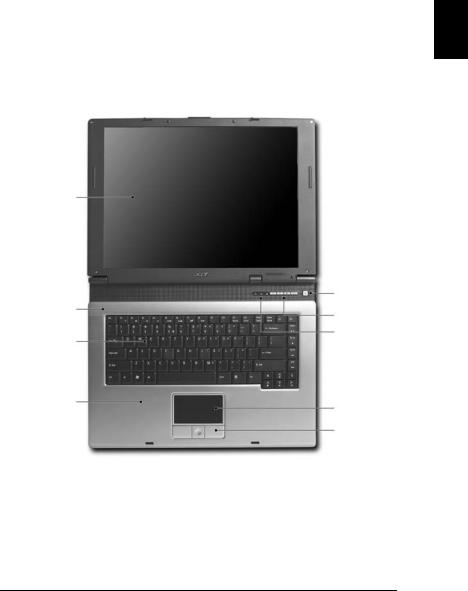
1
An Aspire tour
After setting up your computer as illustrated in the Just for Starters... poster, let us show you around your new Aspire computer.
Front view
1
2 |
9 |
|
8 |
||
|
||
3 |
7 |
|
|
||
4 |
6 |
|
|
||
|
5 |
# |
Item |
Description |
1 |
Display screen |
Also called Liquid-Crystal Display (LCD); displays |
|
|
computer output. |
|
|
|
2 |
Microphone |
Internal microphone for sound recording. |
|
|
|
3 |
Keyboard |
For entering data into your computer. |
English
4 Palmrest |
Comfortable support area for your hands when you use |
|
the computer. |
|
|
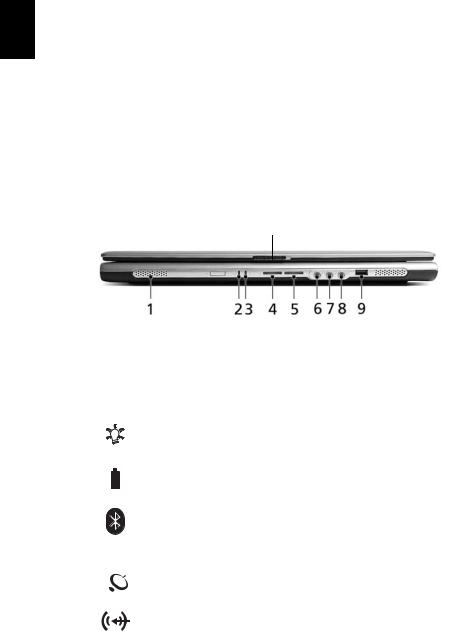
English
2
# |
Item |
Description |
5 |
Click buttons |
The left and right buttons function like the left and |
|
(left, center |
right mouse buttons; the center button serves as a 4-way |
|
and right) |
scroll button. |
|
|
|
6 |
Touchpad |
Touch-sensitive pointing device which functions like a |
|
|
computer mouse. |
|
|
|
7 |
Status |
Light-Emitting Diodes (LEDs) that light up to show the |
|
indicators |
status of the computer's functions and components. |
|
|
|
8 |
Easy-launch |
Buttons for launching frequently used programs. |
|
buttons |
See "Easy-launch buttons" on page 10 for more details. |
|
|
|
9 |
Power button |
Turns the computer on and off. |
|
|
|
Closed front view
10
# |
Icon |
Item |
Description |
||
1 |
|
|
|
Speakers |
Left and right speakers deliver stereo |
|
|
|
|
|
audio output. |
|
|
|
|
|
|
2 |
|
|
|
Power indicator |
Lights up when the computer is on. |
|
|
|
|
|
|
3 |
|
|
|
Battery indicator |
Lights up when the battery is being |
|
|
|
|
|
charged. |
|
|
|
|
|
|
|
|
|
|
|
|
4 |
|
|
|
Bluetooth |
Press to enable/disable the Bluetooth |
|
|
|
|
communication |
function. Indicates the status of |
|
|
|
|
button/indicator |
Bluetooth communication (optional). |
|
|
|
|
(for selected models) |
|
|
|
|
|
|
|
5 |
|
|
|
Wireless |
Press to enable/disable the wireless |
|
|
|
|
communication |
function. Indicates the status of WLAN |
|
|
|
|
button/indicator |
communication (optional). |
|
|
|
|
|
|
6 |
|
|
|
Line-in jack |
Accepts audio line-in devices |
|
|
|
|
|
(e.g., audio CD player, stereo walkman). |
|
|
|
|
|
|
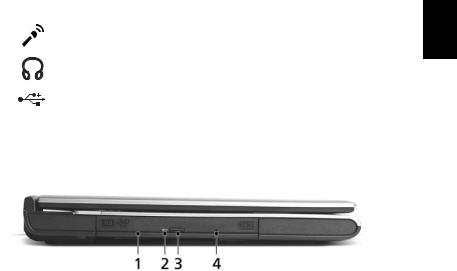
3
# Icon |
Item |
Description |
7 |
Microphone jack |
Accepts input from external |
|
|
microphones. |
|
|
|
8 |
Headphones/speakers/ |
Connects to audio line-out devices |
|
line-out jack |
(e.g., speakers, headphones). |
|
|
|
9 |
USB 2.0 port |
Connect to USB 2.0 devices |
|
|
(e.g., USB mouse, USB camera). |
|
|
|
10 |
Latch |
Locks and releases the lid. |
|
|
|
Left view
English
# |
Item |
Description |
1 |
Optical drive |
Internal optical drive; accepts CDs or DVDs depending |
|
|
on the optical drive type. |
|
|
|
2 |
LED indicator |
Lights up when the optical drive is active. |
|
|
|
3 |
Optical drive |
Ejects the optical drive tray from the drive. |
|
eject button |
|
|
|
|
4 |
Emergency |
Ejects the optical drive tray when the computer is turned |
|
eject hole |
off. |
|
|
|
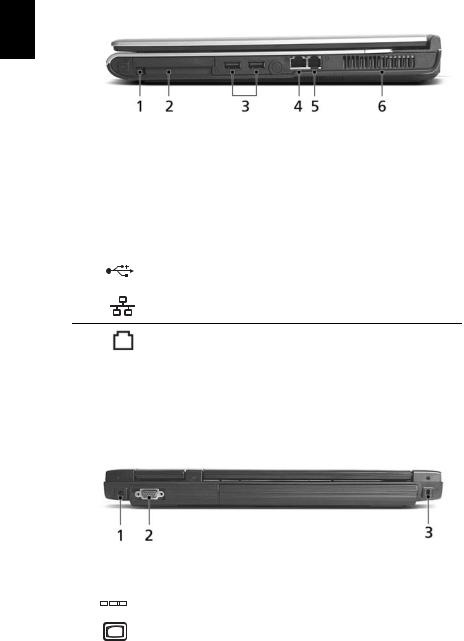
English
4
Right view
# Icon |
Item |
Description |
||||||
1 |
|
|
|
|
|
|
PC Card slot |
Ejects the PC Card from the slot. |
|
|
|
|
|
|
|
eject button |
|
|
|
|
|
|
|
|
|
|
2 |
|
|
|
|
|
|
PC Card slot |
Accepts one Type II PC Card. |
|
|
|
|
|
|
|
|
|
|
|
|
|
|
|
|
|
|
3 |
|
|
|
|
|
|
Two USB 2.0 |
Connect to USB 2.0 devices |
|
|
|
|
|
|
|
ports |
(e.g., USB mouse, USB camera). |
|
|
|
|
|
|
|
|
|
4 |
|
|
|
|
|
|
Ethernet (RJ-45) |
Connects to an Ethernet |
|
|
|
|
|
|
|
port |
10/100-based network. |
5Modem (RJ-11) Connects to a phone line. port
6 |
Ventilation slot Enable the computer to stay cool, |
|
even after prolonged use. |
|
|
Rear view
# |
Icon Item |
Description |
|||||
1 |
|
|
|
|
|
DC-in jack |
Connects to an AC adapter. |
|
|
|
|
|
|||
|
|
|
|
|
|
|
|
|
|
|
|
|
|
|
|
2 |
|
|
|
|
|
External display |
Connects to a display device |
|
|
|
|
|
|
(VGA) port |
(e.g., external monitor, LCD projector). |
|
|
|
|
|
|
|
|
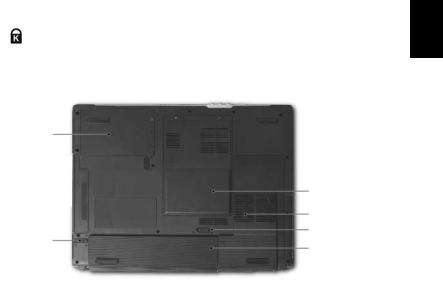
5
# |
Icon Item |
Description |
|
3 |
Kensington lock slot Connects to a Kensington-compatible |
|
|
|
|
computer security lock. |
|
|
|
|
|
Base view |
|
|
|
|
1 |
|
|
|
|
6 |
|
|
|
5 |
|
|
2 |
4 |
|
|
3 |
|
|
|
|
|
|
|
|
|
|
# |
Item |
Description |
|
|
|
|
|
1 |
Hard disk bay |
Houses the computer's hard disk (secured with screws). |
|
|
|
|
|
2 |
Battery |
Releases the battery for removal. |
|
|
release latch |
|
|
|
|
|
|
3 |
Battery bay |
Houses the computer's battery pack. |
|
|
|
|
|
4 |
Battery lock |
Locks the battery in place. |
|
|
|
|
|
5 |
Cooling fan |
Helps keep the computer cool. |
|
|
|
Note: Do not cover or obstruct the opening of the fan. |
|
|
|
|
|
6 |
Memory |
Houses the computer's main memory and Mini PCI card. |
|
|
compartment |
|
|
|
|
|
|
English

English
6
Specifications
Operating |
Microsoft® Windows® XP Home Edition (Service Pack 2) |
system |
Microsoft® Windows® XP Professional (Service Pack 2) |
Platform |
Processor: |
|
• Intel® Pentium® M processor 730/740/750/760/ |
|
770/780 (2 MB L2 cache, 1.60/1.73/1.86/2/2.13/2.26 |
|
GHz, 533 MHz FSB) |
|
• Intel® Pentium® M processor 725/725A (2 MB L2 |
|
cache, 1.60 GHz, 400 MHz FSB) |
|
• Intel® Celeron® M processor 360/370/380 (1 MB |
|
L2 cache, 1.40/1.50/1.60 GHz, 400 MHz FSB) |
|
Chipset: Intel® 915GM |
Memory |
256/512 MB or 1 GB of DDR2 533 memory, upgradeable to |
|
2 GB using two soDIMM modules |
|
|
Display |
15.4" WXGA Acer CrystalBrite color TFT LCD, 1280 x 800 |
|
pixel resolution, supporting simultaneous multi-window |
|
viewing on dual displays via Acer GridVista |
|
15.4" WXGA color TFT LCD, 1280 x 800 pixel resolution, |
|
supporting simultaneous multi-window viewing on dual |
|
displays via Acer GridVista |
|
15" XGA color TFT LCD, supporting 1024 x 768 pixel |
|
resolution |
|
16.7 million colors |
|
|
Graphics |
Intel® 915GM integrated 3D graphics, featuring Intel® |
|
Graphics Media Accelerator 900 and up to 128 MB of |
|
shared memory |
|
Microsoft® DirectX® 9.0 and dual independent display |
|
support |
|
Simultaneous LCD and CRT display with LCD panel |
|
resolution at 70 Hz |
|
Up to 2048 x 1536 resolution via non-interlaced CRT display |
|
MPEG-2/DVD hardware-assisted capability |
|
|
Audio |
Audio system with two built-in speakers |
|
Sound Blaster Pro™ and MS Sound compatible |
|
Built-in microphone |
|
|
Storage |
40/60/80/100 GB ATA/100 hard disk drive |
|
|
Optical |
Choice of: |
media drive |
• DVD-Dual double-layer drive |
|
• DVD/CD-RW combo drive |
|
|

7
Communication |
Modem: 56K ITU V.92 with PTT approval; |
|
|
Wake-on-Ring ready |
|
|
LAN: 10/100 Mbps Ethernet; Wake-on-LAN ready |
|
|
WLAN: integrated 802.11b/g Wi-Fi CERTIFIED™ network |
|
|
solution, supporting Acer SignalUp™ wireless technology |
|
|
WPAN: integrated Bluetooth® |
|
Size and weight |
364 (W) x 279 (D) x 33.9/38.9 (H) mm |
|
|
(14.33 x 10.98 x 1.33/1.53 inches) |
|
|
2.91 kg (6.4 lbs) for 15" LCD model |
|
|
2.94 kg (6.5 lbs) for 15.4" LCD model |
|
|
|
|
Power |
ACPI 1.0b CPU power management standard: supports |
|
|
Standby and Hibernation power-saving modes |
|
|
29.6 W or 65 W Li-ion battery pack |
|
|
2.5-hour rapid charge; 3.5-hour charge-in-use |
|
|
65 W AC adapter |
|
|
|
|
Special keys |
88-/89-key keyboard, inverted "T" cursor layout, 2.5 mm |
|
(minimum) key travel, international language support |
||
and controls |
||
Touchpad with 4-way scroll button |
||
|
||
|
12 function keys, four cursor keys, two Windows® keys, |
|
|
hotkey controls, embedded numeric keypad |
|
|
Four easy-launch buttons: Internet, email, Empowering |
|
|
Key, one user-programmable button |
|
|
Two front-access LED-buttons: WLAN, Bluetooth® |
|
I/O ports |
Three USB 2.0 ports |
|
|
PC card slot (one Type II) |
|
|
External display (VGA) port |
|
|
Headphones/speaker/line-out port |
|
|
Microphone jack |
|
|
Line-in jack |
|
|
Ethernet (RJ-45) port |
|
|
Modem (RJ-11) port |
|
|
DC-in jack for AC adapter |
|
|
|
|
Software |
Acer Arcade |
|
|
Acer eManager (ePowerManagement, eNetManagement, |
|
|
ePresentation, eRecovery, eSettings) |
|
|
Acer GridVista 2.0 |
|
|
Acer Launch Manager |
|
|
Norton AntiVirus™ |
|
|
Adobe® Reader® |
|
|
NTI CD-Maker™ |
English

English
8
Optional items |
8-cell Li-ion battery pack |
|
65 W AC adapter |
|
256/512 MB or 1 GB DDR2 533 MHz soDIMM modules |
|
External USB floppy disk drive |
|
|
Environment |
Temperature: |
|
• Operating: 5 °C to 35 °C |
|
• Non-operating: -20 °C to 65 °C |
|
Humidity (non-condensing): |
|
• Operating: 20% to 80% |
|
• Non-operating: 20% to 80% |
|
|
System |
Mobile PC 2001 |
compliance |
ACPI 1.0b |
|
DMI 2.0 |
|
|
Warranty |
One-year International Travelers Warranty (ITW) |
|
|
Note: The specifications listed above are for reference only. The exact configuration of your PC depends on the model purchased.
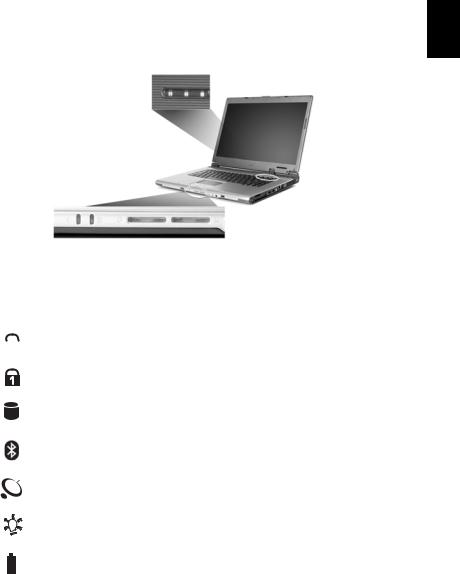
9
Indicators
The computer has three easy-to-read status indicators on the upper-right above the keyboard, and four on the front panel.
The power, battery and wireless communication status indicators are visible even when the LCD display is closed.
Icon |
Function |
Description |
||
|
|
|
|
|
|
|
|
Caps Lock |
Lights up when Caps Lock is activated. |
|
|
|
|
|
|
|
|
|
|
|
|
|
Num Lock |
Lights up when Num Lock is activated. |
|
|
|
|
|
|
|
|
Media activity |
Indicates when the hard disk or optical drive is |
|
|
|
|
active. |
|
|
|
|
|
|
|
|
Bluetooth |
Indicates the status of Bluetooth communication. |
|
|
|
|
|
|
|
|
WLAN |
Indicates the status of WLAN communication. |
|
|
|
|
|
|
|
|
Power |
Lights up when the computer is on. |
|
|
|
|
|
|
|
|
Battery |
Lights up when the battery is being charged. |
|
|
|
|
|
|
|
|
|
|
English
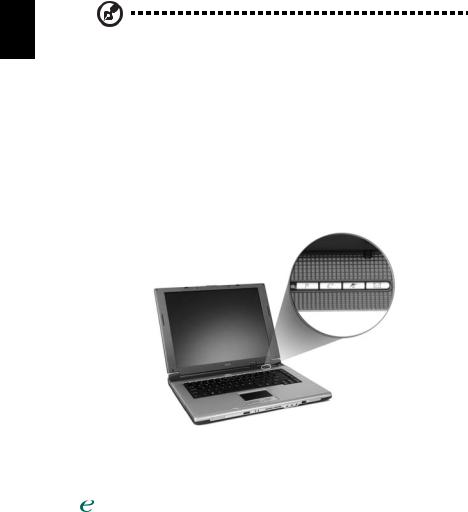
English
10
1.Charging: The light shows amber when the battery is charging.
2.Fully charged: The light shows green when in AC mode.
Easy-launch buttons
Above the keyboard, located at the upper-right, are four buttons. These buttons are called easy-launch buttons. They are: mail, Web browser, Acer
Empowering Key <  > and one user-programmable button.
> and one user-programmable button.
Press <  > to run the Acer eManager. Please see "Acer eManager" on page
> to run the Acer eManager. Please see "Acer eManager" on page
19. The mail and Web browser buttons are pre-set to email and Internet programs, but can be reset by users. To set the Web browser, mail and programmable buttons, run the Acer Launch Manager. See "Launch Manager" on page 21.
Easy-launch button |
Default application |
|
|
P |
User-programmable |
|
|
|
Acer eManager (user-programmable) |
|
|
Web browser |
Internet browser (user-programmable) |
|
|
Email application (user-programmable) |
|
|
|
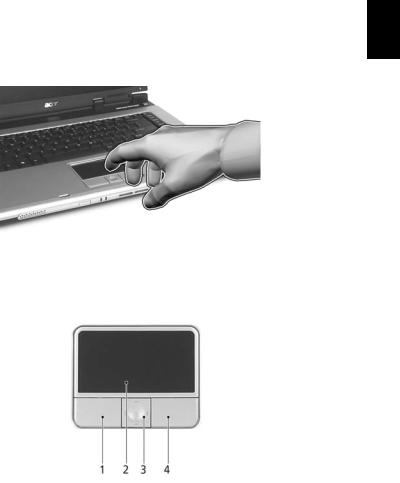
11
Touchpad
The built-in touchpad is a pointing device that senses movement on its surface. This means the cursor responds as you move your finger across the surface of the touchpad. The central location on the palmrest provides optimum comfort and support.
Touchpad basics
The following items show you how to use the touchpad:
•Move your finger across the touchpad (2) to move the cursor.
•Press the left (1) and right (4) buttons located beneath the touchpad to perform selection and execution functions. These two buttons are similar to the left and right buttons on a mouse. Tapping on the touchpad is the same as clicking the left button.
•Use the 4-way scroll (3) button to scroll up or down and move left or right a page. This button mimics your cursor pressing on the right scroll bar of Windows applications.
English

English
12
Function |
Left button (1) |
Right |
Main touchpad (2) |
Center |
button (4) |
button (3) |
|||
|
|
|
|
|
Execute |
Quickly click |
|
Tap twice (at the same |
|
|
twice. |
|
speed as double-clicking |
|
|
|
|
a mouse button). |
|
|
|
|
|
|
Select |
Click once. |
|
Tap once. |
|
|
|
|
|
|
Drag |
Click and hold, |
|
Tap twice (at the same |
|
|
then use |
|
speed as double-clicking |
|
|
finger on the |
|
a mouse button); rest |
|
|
touchpad to |
|
your finger on the |
|
|
drag the |
|
touchpad on the second |
|
|
cursor. |
|
tap and drag the cursor. |
|
|
|
|
|
|
Access |
|
Click |
|
|
context |
|
once. |
|
|
menu |
|
|
|
|
|
|
|
|
|
Scroll |
|
|
|
Click and |
|
|
|
|
hold to |
|
|
|
|
move up/ |
|
|
|
|
down/left/ |
|
|
|
|
right. |
|
|
|
|
|
Note: When using the touchpad, keep it — and your fingers — dry and clean. The touchpad is sensitive to finger movement; hence, the lighter the touch, the better the response. Tapping harder will not increase the touchpad's responsiveness.
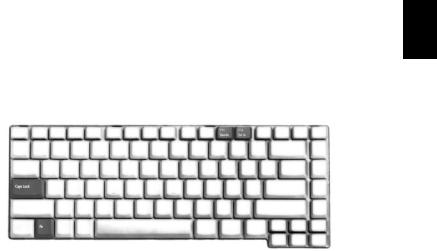
13
Using the keyboard
The keyboard has full-sized keys and an embedded numeric keypad, separate cursor, lock, Windows, function and special keys.
Lock keys and embedded numeric keypad
The keyboard has three lock keys which you can toggle on and off.
English
Lock key |
Description |
Caps Lock |
When Caps Lock is on, all alphabetic characters typed are |
|
in uppercase. |
|
|
Num Lock |
When Num Lock is on, the embedded keypad is in numeric |
<Fn> + <F11> |
mode. The keys function as a calculator (complete with the |
|
arithmetic operators +, -, *, and /). Use this mode when you |
|
need to do a lot of numeric data entry. A better solution |
|
would be to connect an external keypad. |
|
|
Scroll Lock |
When Scroll Lock is on, the screen moves one line up or down |
<Fn> + <F12> |
when you press the up or down arrow keys respectively. |
|
Scroll Lock does not work with some applications. |
|
|
The embedded numeric keypad functions like a desktop numeric keypad. It is indicated by small characters located on the upper-right corner of the keycaps. To simplify the keyboard legend, cursor-control key symbols are not printed on the keys.
Desired access |
Num Lock on |
Num Lock off |
Number keys on |
Type numbers in a normal |
|
embedded keypad |
manner. |
|
|
|
|
Cursor-control keys |
Hold <Shift> while using |
Hold <Fn> while using |
on embedded keypad |
cursor-control keys. |
cursor-control keys. |
|
|
|
Main keyboard keys |
Hold <Fn> while typing |
Type the letters in a |
|
letters on embedded keypad. |
normal manner. |
|
|
|
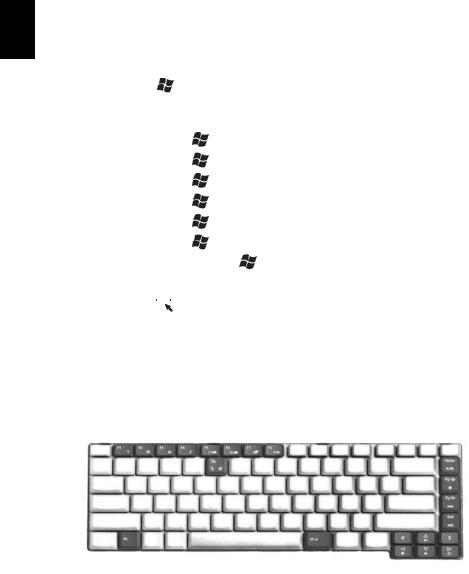
English
14
Windows keys
The keyboard has two keys that perform Windows-specific functions.
Key |
|
|
Description |
Windows key |
|
|
Pressed alone, this key has the same effect as clicking on |
|
|
|
the Windows Start button; it launches the Start menu. |
|
|
|
It can also be used with other keys to provide a variety |
|
|
|
of functions: |
|
|
|
< > + <Tab>: Activates the next Taskbar button. |
|
|
|
< > + <E>: Opens the My Computer window. |
|
|
|
< > + <F1>: Opens Help and Support Center. |
|
|
|
< > + <F>: Opens the Search Results window. |
|
|
|
< > + <R>: Opens the Run dialog box. |
|
|
|
< > + <M>: Minimizes all windows. |
|
|
|
<Shift> + < > + <M>: Undoes the minimize all |
|
|
|
windows action. |
|
|
|
|
Application |
|
|
This key has the same effect as clicking the right mouse |
|
|
||
key |
|
|
button; it opens the application's context menu. |
|
|
||
|
|
|
|
Hotkeys
The computer employs hotkeys or key combinations to access most of the computer's controls like screen brightness, volume output and the BIOS utility.
To activate hotkeys, press and hold the <Fn> key before pressing the other key in the hotkey combination.
